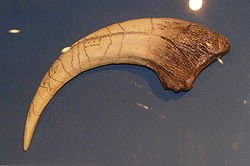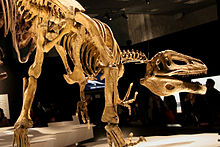- Megaraptor
-
Megaraptor
Temporal range: Late Cretaceous, 98 Ma
Megaraptor claw Scientific classification Kingdom: Animalia Phylum: Chordata Class: Reptilia Superorder: Dinosauria Order: Saurischia Suborder: Theropoda Superfamily: Allosauroidea Family: Neovenatoridae Genus: Megaraptor
Novas, 1998Species M. namunhuaiquii Novas, 1998 (type)
Megaraptor ("giant thief") is a genus of large theropod dinosaur that lived in the Coniacian stage of the Late Cretaceous. Its fossils have been discovered in the Patagonian region of Argentina. Initially thought to have been a giant dromaeosaur-like coelurosaur, it is now classified as a neovenatorid allosauroid.
Contents
Classification
Megaraptor was initially described as a giant dromaeosaur, known primarily from a single claw (about 30 cm long) that resembled the sickle-shaped foot claw of dromaeosaurids.[1] The discovery of a complete front limb, however, showed that this giant claw actually came from the first finger of the hand. The hands were unusually elongated, bearing sickle-shaped claws even more recurved than those of spinosaurids.[2] The hand is quite distinct from other basal tetanurans, so it was not initially clear whether Megaraptor was an allosaurid, a carcharodontosaurid, a spinosauroid, or something else entirely.[3] Subsequent studies, as well as the identification of close relatives with similar large claws on the forelimbs (see below), have helped identify Megaraptor as a highly advanced and lightly built allosauroid, and a member of the family Neovenatoridae.[4]
When first discovered and prior to publication, the spinosaurid Baryonyx was also reported to be a dromaeosaurid, and the allosauroid Chilantaisaurus was reported to be a possible spinosaurid, both based on the large hand claws.
Australian relatives
A close relative of Megaraptor, Australovenator, was discovered in Australia during 2009, helping to solve the mystery of its identity.[4] An additional dinosaur believed to be related to Megaraptor was found in southeastern Australia, Dinosaur Cove. The creature is believed to be around half the size of Megaraptor. It has not yet been named. These finds may show that the breakup of Gondwana was later than once thought.[2]
References
- ^ Novas, F.E. (1998). "Megaraptor namunhuaiquii, gen. et sp. nov., a large-clawed, Late Cretaceous theropod from Patagonia". Journal of Vertebrate Paleontology 18: 4–9. doi:10.1080/02724634.1998.10011030.
- ^ Calvo, J.O., Porfiri, J.D., González-Riga, B.J., and Kellner, A.W. (2007) "A new Cretaceous terrestrial ecosystem from Gondwana with the description of a new sauropod dinosaur". Anais Academia Brasileira Ciencia, 79(3): 529-41.[1]
- ^ Calvo, J. O.; Porfiri, J.D.; Veralli, C.; Novas, F.E.; Poblete, F. (2004). "Phylogenetic status of Megaraptor namunhuaiquii Novas based on a new specimen from Neuquén, Patagonia, Argentina". Ameghiniana 41: 565–575.
- ^ a b Benson, R.B.J.; Carrano, M.T; Brusatte, S.L. (2010). "A new clade of archaic large-bodied predatory dinosaurs (Theropoda: Allosauroidea) that survived to the latest Mesozoic". Naturwissenschaften 97 (1): 71–78. Bibcode 2010NW.....97...71B. doi:10.1007/s00114-009-0614-x. PMID 19826771.
External links
Categories:- Cretaceous dinosaurs
- Dinosaurs of South America
- Carnosaurs
Wikimedia Foundation. 2010.

